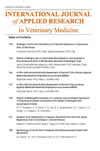Monitoring of viral pathogens in the main Goldfish (Carassius auratus) farms using Immunochemical and Molecular Biology techniques
4区 农林科学
Q4 Veterinary
International Journal of Applied Research in Veterinary Medicine
Pub Date : 2021-09-01
DOI:10.52547/injvr.1.1.27
引用次数: 0
Abstract
Diseases are among the most critical threats to the aquaculture industry so that their prevalence leads to major economic losses. Monitoring for viral pathogens in aquaculture has high importance due to their incurability, speed of transmission, the severity of pathogenesis, and difficulties of their diagnosis. According to reports of goldfish ( Carassius auratus ) losses with suspected viral etiology in farms of Gilan province this study designed to inquiring about the existence of selected viral agents. Thus, the spring viremia of carp (SVC) and Koi herpesvirus (KHV) which are among the notifiable infectious diseases (OIE, 2019) were investigated by cell culture, PCR, RT-PCR, and immunofluorescent antibody test (IFAT). The results showed the absence of the RNA of Rhabdovirus carpio and the DNA of Koi herpesvirus in tested samples. Accordingly, 470 bp band related to SVCV and 292 bp band related to KHV were not confirmed in any of the samples in PCR test as well as neither Cytopathic effect in cell culture nor positive reaction in IFAT were observed. Hence, it seems that non-viral agents are the main causes of periodic population loss of goldfish in the surveyed farms and can be controlled and prevented by the health management procedures.应用免疫化学和分子生物学技术监测主要金鱼养殖场的病毒病原体
疾病是对水产养殖业最严重的威胁之一,其流行造成重大经济损失。由于其不可治愈性、传播速度、发病机制的严重性和诊断的困难,对水产养殖中的病毒性病原体进行监测具有很高的重要性。根据吉兰养鱼场发生的疑似病毒致金鱼死亡的报道,本研究旨在探讨选定的病毒制剂的存在。为此,采用细胞培养、PCR、RT-PCR和免疫荧光抗体检测(IFAT)等方法对法定传染病(OIE, 2019)中的鲤鱼春季病毒血症(SVC)和锦鲤疱疹病毒(KHV)进行了调查。结果表明,样品中不存在鲤鱼横纹蛇病毒RNA和锦鲤疱疹病毒DNA。因此,PCR检测未发现与SVCV相关的470 bp条带和与KHV相关的292 bp条带,细胞培养未见细胞病变作用,IFAT未见阳性反应。因此,非病毒因子似乎是被调查养殖场金鱼周期性种群损失的主要原因,可以通过健康管理程序加以控制和预防。
本文章由计算机程序翻译,如有差异,请以英文原文为准。
求助全文
约1分钟内获得全文
求助全文
来源期刊
自引率
0.00%
发文量
1
审稿时长
3 months
期刊介绍:
The International Journal of Applied Research in Veterinary Medicine promotes excellence in the clinical practice of veterinary medicine by disseminating fundamental scientific, diagnostic, and treatment knowledge gained from prospective and retrospective research in a timely manner. The Journal fulfills its mission through rapid peer review of each submitted article, and publication of all articles within 90 days of acceptance. All published articles meet the standards of Balance, Independence, Objectivity and Scientific Rigor.

 求助内容:
求助内容: 应助结果提醒方式:
应助结果提醒方式:


